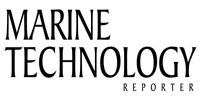
Page 17: of Marine Technology Magazine (July 2025)
Read this page in Pdf, Flash or Html5 edition of July 2025 Marine Technology Magazine
is retrieved, it is possible to verify the closure of bottles, de- depth or time interval relative to its arrival at the sea? oor. The ployment of the drop arm, capture of marine organisms, and achievements obtained with the lander in the Atacama Trench integrity of the data ? les. have been extraordinary, excelling both in the discovery of new
The pro? les obtained by the lander revealed signi? cant species and the analysis of biodiversity and metabolism in this hydrographic variability in the water column in both the environment. These ? ndings not only expand our understand- descending and ascending casts. Among the measured pa- ing of biological diversity in the Atacama Trench but also shed rameters, temperature showed the greatest variability, de- light on the adaptation mechanisms of organisms in the hadal creasing from 17°C to 2.3°C down to 2500m depth (where zone. The versatility of the DAC design allows for the develop- the thermocline was located), stabilizing at approximately ment of new capabilities, such as the introduction of arti? cial 2°C from that depth to 6000m, followed by a slight increase vision techniques and electromechanical traps. Considering due to the adiabatic effect. Maximum variability of dissolved the limited availability of oceanographic instruments capable oxygen was observed at a depth of 500m (oxycline), rang- of operating in hadal conditions, the utilization of Aanderaa ing between 300 and 0µM, with a slight increase to 125µM sensors for dissolved oxygen measurements stands out as a at 700m, a gradual rise to 160µMat at 4000m, and a slight remarkable accomplishment. More work is needed on event decrease at greater depths. triggers, including accelerometers, motion sensors, and pres-
Simultaneously, biodiversity studies in the water column sure sensors. The EdgeTech BART acoustic release is capable have provided key insights into the distribution and structure of outputting 4 additional commands on JP3 AUX header that of metazoans (multicellular animals) at depths greater than could enable expanded functions of the UdeC DAC board, 3000m, which are inaccessible using conventional sampling including delaying the release sequence until commanded, nets. These advances were achieved through environmental enabling long-term deployments. The integration of the two
DNA (eDNA) analysis of samples collected using Niskin appears straightforward, and would give topside researchers bottles, enabling detailed pro? les of species richness and rela- direct command and control of their sea? oor scout in-situ. tive abundance. The results suggest that the ultradeep ocean More sensor manufacturers should make external control of harbors surprising biological richness, often surpassing that their devices possible. More work is needed on hadal depth observed in the surface layers. actuators, including solenoids, ? ash wire releases, motors, and
One of the main remaining challenges during lander deploy- others. Further development of pressure-compensated LiPo ment is preserving viable samples for metabolic analyses, batteries can provide more power safely for less offsetting which are essential for studying the chemical and biological buoyancy. Greater integration of recovery beacons inside the processes that enable organisms to adapt to their environment. upper glass sphere will result in cost, complexity and weight
Genetic material, particularly RNA, is highly susceptible to savings, such as the Global Ocean Design Beacon Board that degradation due to changes in pressure, temperature, and time triggers on burnwire activation. Exploring hadal zones pres- required to recover the samples. This underscores the urgency ents a vast ? eld for technological advancement today, owing to of developing in-situ preservation techniques that minimize both technical challenges and limited commercial incentives.
the alteration of genetic material.
Despite these limitations, valuable results have been obtained through adapted protocols for analyzing degraded material.
Although these methodologies provide limited coverage of metabolic pathways, they highlight the need for innovation in
Acknowledgements more robust technologies. Such advancements will be funda- *T is MTR story is an adaptation of the IEEE-OES paper “Versatile
Data Acquisition and Control System for Free-Fall Underwater mental for exploring the adaptations that sustain life in hadal
Vehicles: Exploring Hadal Waters”. T e full IEEE text may be found ecosystems, offering new perspectives on the evolutionary at
processes in these extreme environments.
MTR acknowledges the full suite of authors of the IEEE-OES paper: Víctor Villagrán, José I. Cifuentes, Óscar Pizarro, Nadin
Conclusions and Future Opportunities
Ramírez, Pablo Oliva, Kevin Hardy, Carolina E. González, and
This article presents an integrated observation system that en-
Osvaldo Ulloa.
ables the physical and biogeochemical study of the deep ocean. “Lander Lab” is a hands-on column of Ocean Lander tech-
The lander’s successful mission in the Atacama Trench dem- nologies, a unique class of unmanned undersea vehicles, and the people who make them. It is meant to serve the global ocean onstrates the broad potential of this platform to contribute to lander community in the manner of Make Magazine and other the characterization of unexplored regions of the sea. The data
DIY communities.
acquisition system allows oceanographic instruments to be
Comments on this article, or suggestions for stories of interest to adaptively con? gured in real time, making them more ef? cient other Landereans are welcome. Other ocean lander teams are en- in their use by introducing pro? ling and moored modes. The couraged to write in about their work. MTR invites you to contact system controls tasks involving mechanical actuation and of-
Kevin Hardy
fers different activation methods based on either the vehicle’s www.marinetechnologynews.com 17
MTR #5 (1-17).indd 17 MTR #5 (1-17).indd 17 7/29/2025 2:31:29 PM7/29/2025 2:31:29 PM

 16
16

 18
18
